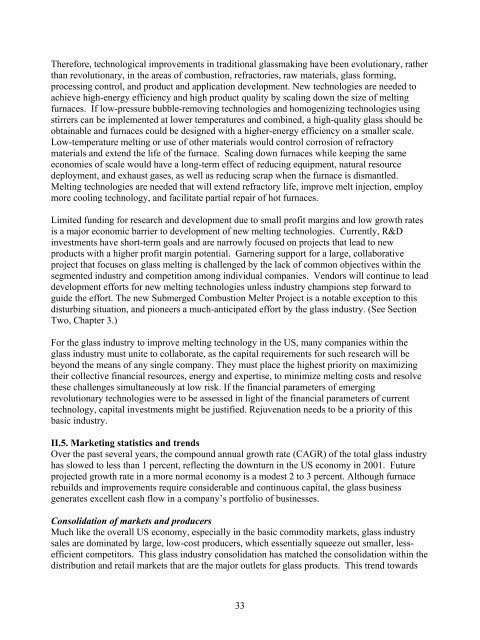Glass Melting Technology: A Technical and Economic ... - OSTI
Glass Melting Technology: A Technical and Economic ... - OSTI
Glass Melting Technology: A Technical and Economic ... - OSTI
Create successful ePaper yourself
Turn your PDF publications into a flip-book with our unique Google optimized e-Paper software.
Therefore, technological improvements in traditional glassmaking have been evolutionary, rather<br />
than revolutionary, in the areas of combustion, refractories, raw materials, glass forming,<br />
processing control, <strong>and</strong> product <strong>and</strong> application development. New technologies are needed to<br />
achieve high-energy efficiency <strong>and</strong> high product quality by scaling down the size of melting<br />
furnaces. If low-pressure bubble-removing technologies <strong>and</strong> homogenizing technologies using<br />
stirrers can be implemented at lower temperatures <strong>and</strong> combined, a high-quality glass should be<br />
obtainable <strong>and</strong> furnaces could be designed with a higher-energy efficiency on a smaller scale.<br />
Low-temperature melting or use of other materials would control corrosion of refractory<br />
materials <strong>and</strong> extend the life of the furnace. Scaling down furnaces while keeping the same<br />
economies of scale would have a long-term effect of reducing equipment, natural resource<br />
deployment, <strong>and</strong> exhaust gases, as well as reducing scrap when the furnace is dismantled.<br />
<strong>Melting</strong> technologies are needed that will extend refractory life, improve melt injection, employ<br />
more cooling technology, <strong>and</strong> facilitate partial repair of hot furnaces.<br />
Limited funding for research <strong>and</strong> development due to small profit margins <strong>and</strong> low growth rates<br />
is a major economic barrier to development of new melting technologies. Currently, R&D<br />
investments have short-term goals <strong>and</strong> are narrowly focused on projects that lead to new<br />
products with a higher profit margin potential. Garnering support for a large, collaborative<br />
project that focuses on glass melting is challenged by the lack of common objectives within the<br />
segmented industry <strong>and</strong> competition among individual companies. Vendors will continue to lead<br />
development efforts for new melting technologies unless industry champions step forward to<br />
guide the effort. The new Submerged Combustion Melter Project is a notable exception to this<br />
disturbing situation, <strong>and</strong> pioneers a much-anticipated effort by the glass industry. (See Section<br />
Two, Chapter 3.)<br />
For the glass industry to improve melting technology in the US, many companies within the<br />
glass industry must unite to collaborate, as the capital requirements for such research will be<br />
beyond the means of any single company. They must place the highest priority on maximizing<br />
their collective financial resources, energy <strong>and</strong> expertise, to minimize melting costs <strong>and</strong> resolve<br />
these challenges simultaneously at low risk. If the financial parameters of emerging<br />
revolutionary technologies were to be assessed in light of the financial parameters of current<br />
technology, capital investments might be justified. Rejuvenation needs to be a priority of this<br />
basic industry.<br />
II.5. Marketing statistics <strong>and</strong> trends<br />
Over the past several years, the compound annual growth rate (CAGR) of the total glass industry<br />
has slowed to less than 1 percent, reflecting the downturn in the US economy in 2001. Future<br />
projected growth rate in a more normal economy is a modest 2 to 3 percent. Although furnace<br />
rebuilds <strong>and</strong> improvements require considerable <strong>and</strong> continuous capital, the glass business<br />
generates excellent cash flow in a company’s portfolio of businesses.<br />
Consolidation of markets <strong>and</strong> producers<br />
Much like the overall US economy, especially in the basic commodity markets, glass industry<br />
sales are dominated by large, low-cost producers, which essentially squeeze out smaller, lessefficient<br />
competitors. This glass industry consolidation has matched the consolidation within the<br />
distribution <strong>and</strong> retail markets that are the major outlets for glass products. This trend towards<br />
33

















